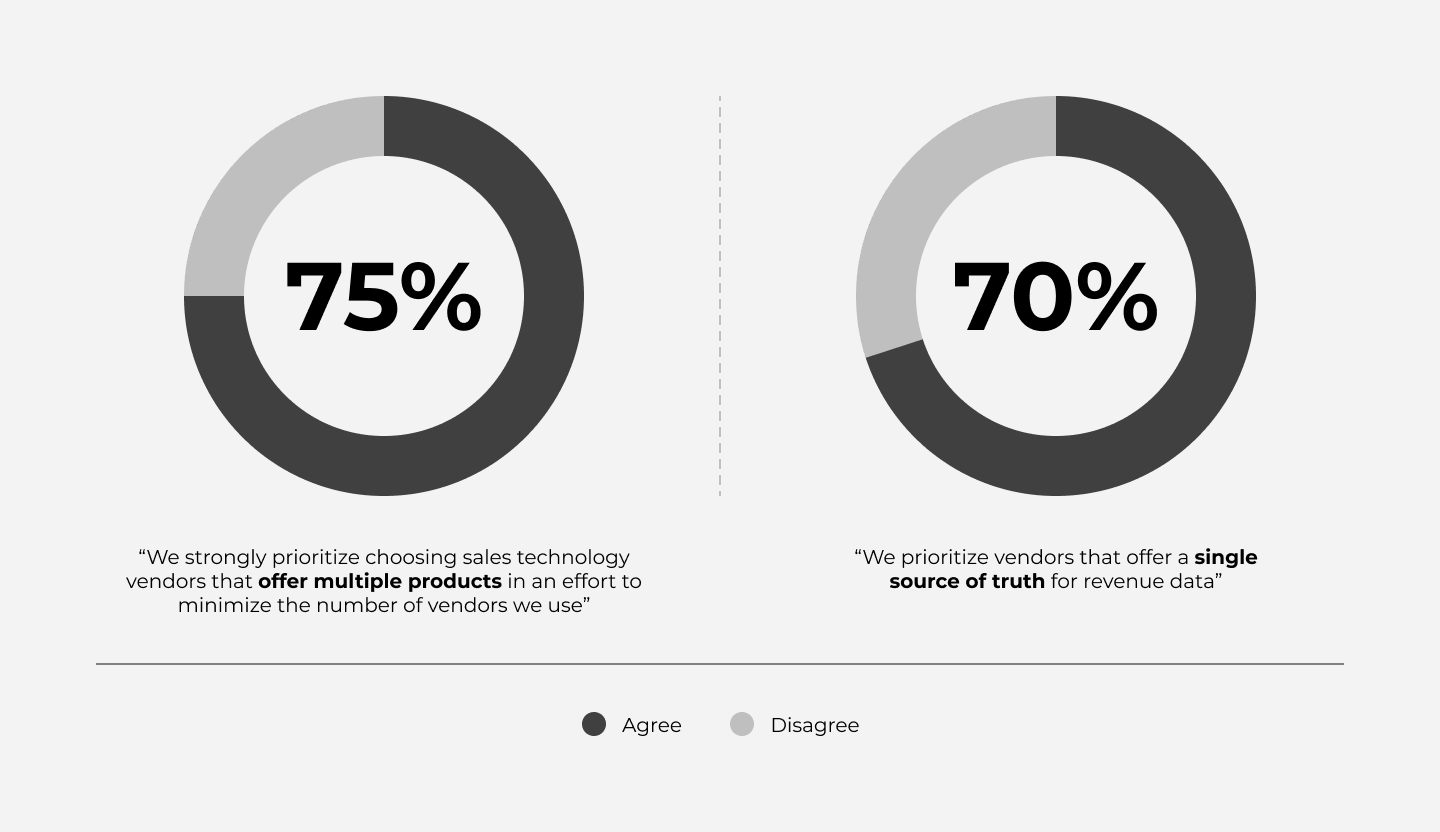10.6 minutes

Key Challenges
Today’s chief revenue officers (CRO) have clear mandates: deliver predictable efficient growth, maintain competitive advantage, and ensure their sellers deliver experiences today’s business buyers demand. New technologies, specifically those that leverage Generative AI (GenAI), play an increasingly important role in ensuring these leaders deliver against this charter. While it’s still early days, the current and future potential of GenAI to instrument and inform buyside and sellside processes and activities is immense. Before CROs, and their sales technology committees, architect and roll out their AI sales strategy, they must be prepared to address common challenges including:
- Bloated RevTech stacks. As a result of multiple disparate tools and siloed data sets, CROs have poor visibility into pipeline and forecast efficacy, sellers lose time toggling between apps, RevOps leaders pay multiple vendors for duplicative capabilities, and buyers experience disconnected journeys.
- Suboptimal data strategies. Selling organizations that operate without a unified centralized data repository will find themselves disadvantaged. Inaccurate and incomplete data limits the machine learning models’ ability to learn and adapt leading to suboptimal outputs.
- How to prioritize what to focus on. There’s so much hype swirling around the current and future potential of GenAI that it’s difficult to unravel where to start. Focus on the initiatives that will deliver immediate and measurable business results.
Recommendations
- Streamline your RevTech stack. Evaluate each of your vendor’s solutions to better understand the full scope of capabilities. Lean into vendors that have comprehensive existing GenAI capabilities and a compelling future road map. Create a plan to wind down all other vendor relationships.
- Establish a unified data foundation. Understand what data you possess, where it is located, and what’s missing. Establish a unified data foundation to help simplify data retrieval and eliminate the need for time-consuming searches across different data sources.
- Set up a GenAI working group. Put together a group of cross-functional professionals whose remit is to learn what’s possible. Deep knowledge of your internal systems and process maturity combined with external learnings from vendors, competitors, and industry experts, will enable this group to provide clear recommendations on how to get started.
Analysis
Over the last 10 years many sales organizations, even those in traditional industries, have cobbled together a disjointed array of RevTech solutions. While it made sense circa 2015 to weave together best-of-breed solutions, today it does not. The best RevTech players have systematically extended their capabilities over the last decade. These vendors now deliver functionalities including content management, intelligence, forecasting, sequencing, and call coaching in a unified platform, suite, or action hub.
Historically, RevTech consolidation was driven by vendors looking to exercise their cross-sell muscle but dynamics are changing. In a recent study of North American revenue leaders, 59% of respondents said they have been asked to or are actively trying to consolidate their RevTech stacks.1 Whether it’s to benefit from a platform approach, maximize their teams’ efficiencies, eliminate tech redundancies, and/or because they want a unified set of buyer and seller activity data, 75% of organizations now prioritize selecting vendors that offer a connected suite of multiple products. (see figure 1).2
With the rapid maturation of GenAI, selling organizations that operate without a unified centralized data repository will quickly find themselves disadvantaged. Inaccurate and incomplete buyer and seller activity data will limit the machine learning models’ ability to learn and adapt resulting in subpar outputs of intelligence, insights, recommendations, and content.
While the proliferation of digital interactions generates vast amounts of data, when different functions within an organization rely on multiple data sources, inefficiencies abound. In addition to time wasted when searching for data across multiple repositories, the lack of a unified data foundation minimizes the impact of insights, and leads to fragmented buyer experiences. In that same study, 70% of technology buyers stated they also prioritize vendors that offer a single source of truth for revenue data (see figure 1).3
By 2025, Gartner predicts that 30% of outbound marketing messages from large organizations will be synthetically generated.4 While it’s exciting to envision future possibilities such as simulated role-play scenarios, hyper-personalized pitch decks tailored to each buyer, and much more, CROs must focus on the here and now. GenAI capabilities available today can help CROs and revenue teams get quick feedback on the health of deals, pipelines, and forecasts, improve retention, create email sequences, generate one-off emails, and obtain answers to account specific questions.
With so many readily available use cases, and the business impact GenAI can drive, CROs must quickly develop a basic working knowledge of the technology. There is no reason to delay as even revenue organizations that experiment with GenAl without a fully developed strategy see benefits. Our study found that 59% of revenue teams currently use or experiment with GenAI to accomplish tasks and that high-performing organizations are 44% more likely than lower performing peers to use or experiment with GenAI (see figure 2).5
In recent years, The role of the CRO has changed. Sales technology budgets have increased, sales headcount budgets have been redirected to technology spends, and CROs are expected to deliver efficient predictable growth.6 Smart tooling, having the right collection of technologies for revenue team members to excel, is playing an increasingly important role in the successful execution of sales strategies. CROs must now have an effective working knowledge of relevant innovative technologies.
Figure 1: Buyers prioritize vendors that offer multiple products and a single source of data truth

Figure 2: Successful revenue teams are experimenting with GenAI today

As you move forward, take stock of the tools in your RevTech stack. Meet with executives at leading vendors to learn about current AI capabilities, future plans, and roadmap prioritizations. Reduce organizational data silos and ensure insights, recommendations, and content creation are based on a robust and consistent data set. As you finalize your AI sales strategy, don’t get caught up in the hype of what’s possible years from now. Focus on a clear set of business processes and activities that will deliver measurable business results today. Finally, embrace GenAI and other innovative technologies as important arrows in your quiver to help you successfully operationalize your sales strategy.
To set your organization up for success:
Partner with multi-product AI-ready vendors. As you streamline your RevTech stack, prioritize working with vendors that have actual working GenAI capabilities and that offer a wide range of functionality that can be leveraged across the entire revenue cycle. Commit to vendors that have thoughtfully and safely integrated GenAI into their platform. Carefully evaluate their security and privacy certifications to mitigate risk.
Organize your data into a single source of truth. The success of your GenAI strategy hinges on the quality of your data. To get the most out of the initiative, ensure your data is well-structured and centrally stored. A unified repository allows for efficient access to essential information, for responses to prompts, and increases the likelihood of precise and accurate answers.
Prioritize use cases that make a quantifiable impact. With so much hype around the technology, it’s important to prioritize use cases that tightly align to your sales strategy, and when executed at scale, have a high probability of delivering quantifiable business outcomes. As always, find a healthy balance between what’s possible, what your organization can consume, and what will deliver the best results. Prioritize use cases where you will reap the biggest measurable returns.
Create policies and procedures to mitigate risk. Like any other emergent transformational technology, GenAI has benefits and risks. While the potential benefits, particularly within the world of revenue, outweigh the risks, it’s important to create guardrails. Develop clear usage policies and boundaries to reduce risk. Focus on responsible use, iterate and then learn from mistakes. Knowledge gathered today will not only help your initiative be successful now but will also set your organization up for future success as capabilities become more robust.
Conclusion
Buying and selling in the business world, as well as the underlying technologies that enable both processes, are at critical inflection points. Business buyers demand consumer-like experiences, sellers expect access to the best technologies, and CROs must do more with less. Since its commercial launch in November 2022, GenAI is maturing at a breakneck pace. CROs that intend to outperform the competition, keep buyers engaged, support today’s agile technology-enabled sales force, and deliver predictable efficient growth cannot afford to delay.
1 Dynata survey of 300 North American revenue leaders on behalf of Mediafly, July 2023.
2 Dynata survey of 300 North American revenue leaders on behalf of Mediafly, July 2023.
3 Dynata survey of 300 North American revenue leaders on behalf of Mediafly, July 2023.
4 Gartner, Gartner Experts Answer the Top GenerativeAI Questions for Your Enterprise.
5 Dynata survey of 300 North American revenue leaders on behalf of Mediafly, July 2023.
6 Dynata survey of 300 North American revenue leaders on behalf of Mediafly, July 2023.
